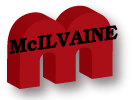
Coronavirus Technology Solutions
June 29, 2020
The Coronavirus Task Force has Finally Stated
That Masks Protect the Wearer
Efficient Masks Should be the Primary Weapon to
Vanquish COVID
Berry Global to Supply Medicom with Media for
Hundreds of Millions of Face Masks per Year
Low & Bonar Teams with AFPR0 on Masks
New York Malls will Need High Quality Air
Systems Before They can Reopen
Masks are the Most Effective Way to Vanquish
COVID Despite Criticism
of Papers with this Conclusion
O2 Canada has Efficient Mask with Insertable
Filters
Totobobo has Reusable Mask with
Electrostatically Enhanced Filters
Respro® Mask has High Efficiency Valved Masks
and Lower Efficiency Scarves
_____________________________________________________________________________
The Coronavirus Task Force has Finally Stated
That Masks Protect the Wearer
Both Dr. Birx and Fauci
made such statements in the last few
days. Dr. Deborah
Birx said that scientific evidence shows that
masks both “keep you from infecting others and
protects you from getting infected.”
Dr. Birx said Sunday that there is "clear
scientific evidence" that masks work -- adding
that she assumes President Donald Trump is able
to keep six feet of distance "in a majority of
cases" when pressed on whether he should wear
one.
"What we have said to people is there is clear
scientific evidence now, by all the droplet
experiments that happened, and that others have
done, to show that a mask does prevent droplets
from reaching others," Birx said on "Fox News
Sunday" when asked what she would tell people
who say they have a right not to wear a mask in
public.
"Out of respect for each other, as Americans
that care for each other, we need to be wearing
masks in public when we cannot social distance,"
she said.
Efficient Masks Should be the Primary Weapon to
Vanquish COVID
If everyone including transmitters and
recipients were correctly wearing N100 masks
there would be no COVID transmission. If
everyone wore an N30 mask the infection rate
would only be cut in half. So mask efficiency
makes a huge difference.
We have to separate capability from operability
and then upgrade the operability to utilize the
maximum capability.
Health officials confused operability and
capability from the earliest days in the COVID
spread. Even after it became apparent that
40-60% of the transmission was from individuals
with no signs like coughing or sneezing
officials resisted the mandate to require
efficient N95 masks.
The reasoning was that they were in short
supply and needed by healthcare workers.
Since lower efficiency e.g. N30 masks could be
made available, they were recommended on the
basis that most of the transmission was from
coughing and sneezing of large droplets. There
was never any claim that these masks would
prevent exhalation of small virus aerosols
generated by breathing, talking, or singing. Now
that it is proven that these small aerosols are
responsible for most of the transmission
inefficient masks are of little value.
When both transmitter and recipient are wearing
95% efficient masks the recipient inhales only
0.25% of the virus
N95 Mask

Compare this to the N30 mask where the
combination results in the recipient inhaling
49% of the virus.
N30 Mask

The N30 masks result in nearly 200 x the virus
inhalation of the N95 mask.
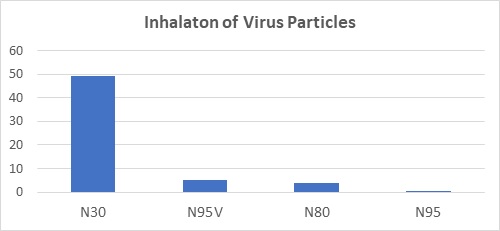
The N80 mask would result in only 4 %
inhalation. This makes it 12 times better than
the N30.
Even the N95V mask with a valve is very
good with only a 5% inhalation. It is 10 times
better than an N30 mask.
There are arguments
that the virus is transmitted from surfaces to
the hands then to the eyes or nose. However, if
everyone is wearing an efficient mask there will
be no virus on surfaces.
It is now clear that masks have the capability
to vanquish COVID the challenge is now to
improve the operability.
Operability
The two critical aspects of operability are
availability and execution. Availability is
limited by
mask media as well as mask production.
The meltblown media production has expanded
considerably. However, it is only a small
percentage of what would be needed for 3 billion
people to be wearing N95 masks. Sinopec
demonstrated that in three months you can add
enough capacity to make 10 million masks per
day. However if people use disposable meltblown
N95 masks, the daily mask production could be as
much as 1 billion masks per day. This would
require an effort 100 x larger than the Sinopec
effort or the equivalent of 100 more producers
the size of 3M.
An alternative is the N80 mask using spun bond
media. 30,000 extra tons per year would be
needed. U.S. non
global nameplate capacity of spunbonded/spunmelt
polypropylene nonwovens is over 4.7 billion tons
per year. So this requirement is comparatively
small when compared to disposable diapers.
Nanofibers offer another alternative with
potential for higher efficiency and lower
resistance.
This approach does not rely on a
permanent electrostatic effect. Therefore these
masks are washable. Nanofiber laminate media can
be readily available.
Many companies are making masks and many more
are eager to do so.
There are critical design aspects such as
obtaining the right fit and maximizing
breathability. But there are no great hurdles to
overcome.
Execution:
There may need to be some funding for masks in
developing countries. But the cost of masks will
be far less than the cost of any other approach
to defeat COVID. At $100 per year per person x 3
billion people we are looking at a $300 billion
yearly market. This is sizable enough to warrant
the attention of the world’s largest fabric and
PPE companies.
The first task is to correct the misinformation
and help governments understand the importance
of the mask initiative. At the same time the
suppliers have to have plans in place to expand
to meet demand. McIlvaine is addressing the
needs with a three pronged program in
Coronavirus Technology Solutions. Each
initiative includes daily Alert coverage,
webinars and analysis. The initiatives are
1.
Masks and other PPE
2.
Filters and HVAC
3.
Decontamination, monitoring and other products
Berry Global to Supply Medicom with Media for
Hundreds of Millions of Face Masks per Year
Berry Global is
collaborating with The Medicom Group, (Medicom),
to design the manufacturing solution and
guarantee the supply of nonwoven fabric intended
for use in producing hundreds of millions of
face masks annually as part of Medicom’s
agreement with the British Government. Medicom
is one of the world’s leading manufacturers of
medical and respiratory masks.
To do so, Berry
is investing in a new state-of-the-art meltblown
nonwovens line, to be outfitted with its
proprietary charging technology, at one of its
U.K. based facilities to increase capacity of
material necessary in the production of
European-standard Type IIR and N99-equivalent
FFP3 masks. The masks will be manufactured and
sold under Medicom’s European Kolmi brand.
The British
Government has enabled these investments through
a long-term contractual commitment. The
agreement confirmed support for Medicom’s new
U.K.-based production facility, which is
scheduled to open later this summer. This move
highlights the focus governments are placing on
securing a supply chain that helps ensure a
local supply of personal protective equipment.
“Berry has deep
roots in the U.K. We are pleased to support
Medicom as they open their new facility and help
advance safety and protection in the region well
beyond the COVID-19 pandemic,” says Curt Begle,
president of Berry’s Health, Hygiene, and
Specialties Division.
Low & Bonar Teams with AFPR0 on Masks
Low & Bonar's Colback
nonwovens are now included as a reinforcement
layer in FFP2-certified medical face masks. The
masks themselves are produced by another company
located in the Netherlands: AFPRO Filters.
Though both companies were new to the face mask
business, they made it happen within a very
short period.
As in many other countries, the Netherlands was
confronted with a global shortage of personal
protective equipment as COVID-19 spread across
the continents. Called upon by the Dutch
Minister of Health and Sports, a unique
public/private consortium came to existence,
with selected Dutch companies invited to join
and serve a single purpose: the realization of
large-scale, non-profit based production of
health protection items within the country to
help protect their healthcare workers. Without a
second thought, both Low & Bonar and AFPRO
Filters became part of this consortium and soon
started to work on medical face masks together.
Shouldering responsibility, both companies
deliver at cost price. The consortium
distributes the medical masks evenly or wherever
the need in national healthcare institutions is
greatest.
“Although neither of us had ventured into face
masks before, we could build on long-standing
expertise within our fields and believed we
could make it work,” says Low & Bonar business
development manager Edgar Berkhout. “AFPRO
Filters is a long-standing producer of filter
systems, an industry we are very familiar with.
We know our product and production capabilities
inside out and have many in-house testing
facilities at our disposal. Thanks to that, and
through our intensive collaboration, we were
able to move fast.”
Niels Berkhout, supply chain director at AFPRO
Filters, adds: “We felt an enormous urgency to
turn this project into a success and found an
equal dedication at Low & Bonar. We experienced
a very high degree of flexibility among all
involved: engineering, production, planning and
deliveries. So much technical knowledge was made
available to us and always at very short notice.
Together we were able to overcome all the
obstacles along the way.”
Colback is a
spunbond nonwoven. Its role in these
FFP2-approved face masks is one of
reinforcement. As an intermediate layer Colback
provides the necessary sturdiness to the masks,
keeping them in shape and place during wear. At
the same time, Colback is very light-weight,
thin and highly permeable which allows for easy
breathing and improves user comfort. Customers
benefit from Colback´s straightforward
processing. Colback is very suitable for
ultrasonic welding, among other things, and it
cuts without any fraying or curling.
“Our main
mission is to bring value to our customers. By
tailoring our product and fine-tuning all its
technical details to the exact needs of these
face masks, adding value is exactly what we did.
And in doing so, we are able to contribute in a
non-profit manner to the current urgent needs of
our society,” concludes Berkhout.
AFPRO makes a range of filters from low
efficiency panel filters to HEPA. Each
individual filtHEPA filter is tested in
accordance with the EN1822 standard.
New York Malls will Need High Quality Air
Systems Before They can Reopen
New York malls will need high quality air
systems that can filter out the coronavirus
before they will be allowed to reopen, Gov.
Andrew Cuomo said on Monday.
“Any malls that will open in New York, large
malls, we will make it mandatory that they have
air filtration systems that can filter out the
COVID virus,” Cuomo said at a press briefing.
High efficiency particle air filters, or HEPA
filters, have been shown to help reduce the
presence of Covid-19 in the air, according to a
presentation from Cuomo.
The U.S. Centers for Disease Control and
Prevention says the coronavirus is thought to
spread primarily through person-to-person
contact, when an infected person produces
respiratory droplets by coughing, sneezing or
talking in close contact with other people. It’s
possible someone can become infected by touching
a surface and then touching their mouth, nose or
eyes, but that’s not considered to be the main
way the virus is transmitted, the
CDC says.
Some epidemiologists say the virus also appears
to spread through exhaled air when people talk
or breathe, known as aerosols, according to Nature.
The coronavirus’ particle has a diameter of
about .125 micron, he said, pointing to recent
studies.
HEPA filters are designed to filter particles
that are .01 micron and above.
New York has not allowed malls to reopen in the
state yet, Cuomo said. He said the state
recommends all businesses and offices “explore
the potential for their air conditioning air
filtration system.”
New Jersey allowed malls to reopen on Monday
while following the same health precautions
required of other stores but without advanced
filtration systems, according to the state’s
guidelines.
Cuomo has allowed other businesses to reopen
without installing high-end filtration systems.
So far, indoor retail, except for malls, indoor
and outdoor dining and some office spaces have
reopened in different regions of the state with
reduced capacity.
New York City is expected to begin on July 6 its
next phase of reopening, which will allow for
indoor dining and personal care services such as
nail salons, spas, massage parlors, and tattoo
and piercing facilities with limited occupancy.
Cuomo said on Monday, however, that he’s
concerned about the city’s enforcement of
previous reopenings and that it has experienced
a lack of compliance when it comes to social
distancing and mask wearing, he said.
“You can see it in pictures, you can see it if
you walk down the street, you can see the crowds
in front of bars, you can see the crowds on
street corners. It is undeniable,” Cuomo said.
Masks are the Most Effective Way to Vanquish
COVID Despite Criticism of Papers with this
Conclusion
We have provided detailed coverage of a June 11
article showing that masks are the most
effective way to vanquish COVID and
observe that whether or not some of their
approaches were flawed their conclusion was
correct. There is good coverage of this dispute
in VOX.
A high-profile dispute between researchers over
a study on the role of face masks in
preventing Covid-19 is revealing the tensions in
how science is conducted during a global
pandemic. It’s also raising questions about the
role of prestigious journals in elevating
findings that may not hold up.
In the latest development, the authors of a
controversial study on the effectiveness of face
masks, published on June 11 in the journal Proceedings
of the National Academy of Sciences (PNAS),
are pushing back against calls to retract the
paper.
On June 24, the authors issued a rebuttal
statement to
a petition signed
by more than 40 scientists who identified
“egregious errors” in the original study.
The study examined how Covid-19 spreads through
the air and found that “wearing of face masks in
public corresponds to the most effective means
to prevent interhuman transmission.” While the
authors are not epidemiologists, Nobel
Prize-winning atmospheric chemist Mario Molina
is among its authors.
The finding that masks are a good way to slow
the pandemic aligns with other
research,
as well
as the guidance from health agencies that
now recommend wearing them. But the idea that
they’re the “most effective means” to do so,
compared with tactics like social distancing,
banning large gatherings, and closing
businesses, is a controversial claim. And the
scientists calling for a retraction say the
evidence presented doesn’t back it up; they
found serious flaws with the study’s methodology
and some of its underlying assumptions.
In their letter
to PNAS calling
for the retraction, the critics write: “While
masks are almost certainly an effective public
health measure for preventing and slowing the
spread of SARS-CoV-2, the claims presented in
this study are dangerously misleading and lack
any basis in evidence,” according to the letter.
The call for a retraction follows two other
recent high-profile
retractions in
other major scientific journals withdrawn by the
request of their authors who found problems in
their own data. But it’s highly unusual for one
group of scientists to publicly rebuke a piece
of research by another, as with the recent PNAS
study.
That raises the question of how to bring more
researchers to the table and speed up the reveal
of valuable information about Covid-19 without
sacrificing the integrity of the process.
For their part, the authors said in their rebuttal
statement that
the sentence referring to differences between
New York City and the rest of the country was
taken out of context. It was specifically
referring to federal policies across the United
States as a whole compared to policies in New
York City, rather than comparing the city to
other cities or states. (Molina also wrote a
rebuttal making similar points in El
Universal in
Spanish.)
As for the straight trend lines across curves,
the authors insist that it was appropriate. “A
simple inspection of the data indicates a
remarkable linearity in the portions of the
figures we highlight,” they wrote.
And the authors said the criticisms stem from
academic gatekeeping. “It is truly incredible
how the authors [of the retraction petition]
could come up with such naïve ideas, merely
because no COVID-19 epidemiologist was among the
authors of our paper,” the authors wrote in
their rebuttal.
In this case, both the authors and the reviewers
of the study were not epidemiologists, as might
be expected for a paper on this topic, but
scientists who study aerosols.
“I really highly doubt it would have been
published in PNAS if it had gone through the
regular channel,” Grabowski said.
With the swarm of research on Covid-19, it’s
inevitable that some questionable findings would
emerge. Part of it stems from the circumstances.
The disease has only been circulating for a few
months, so there hasn’t been enough time to set
up robust controlled studies. Many papers are
based on observations rather than experiments,
but done right, these studies can still yield
useful information.
In any case the filtration industry also needs
to start providing academics with more
information and help them understand aspects
such as the difference between filters. This
whole dispute relies on a statistical approach.
Since we do not know how many New Yorkers were
wearing high efficiency masks and how many were
just wearing bandanas the impact of the mask
mandate is in question.
https://www.vox.com/2020/6/29/21302489/coronavirus-face-mask-covid-19-pnas-study
O2 Canada has Efficient Mask with Insertable
Filters
O2 Canada is a Canadian business founded in
2014. It is a Class 1 Medical Device company
registered with Health Canada. The
company mission is to help millions of people
breathe clean air.
Peter Whitby covered the history in his blog
“When we started studying air pollution and
engineering masks, we carried out research at
the Air Pollution Research and Innovation
Laboratory at the University of Waterloo. This
is now the Green Energy and Pollution Control
Research Lab. During our studies of dust masks
and disposable masks, we learned that leakage is
the biggest challenge. Air is like water in that
it takes the path of least resistance and any
gap will result in unfiltered air bypassing the
mask. This led us to focus on developing the
high-performing medical-grade silicone seal for
our mask, the O2 Curve.”
In testing at the Green Energy and Pollution
Control Research Lab, O2 achieved filtration
efficiency of 98.6% against PM2.5. The testing
covered particle sizes ranging from 0.5 to 5.0
microns.
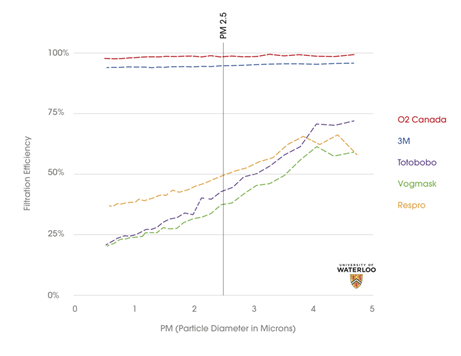
Experimental testing of masks and filters was
initiated by Professor Zhongchao Tan at the Air
Pollution Research Lab. A quantitative
respirator fit testing (QNFT) was conducted to
quantify the leakage between the respirator
(i.e. dust mask) and the face.
Five different masks and their filter membranes
were tested on three different facial sizes
(using mannequins) to assess performance on
different facial profiles. Here were the key
findings:
-
Performance of dust masks
depends on both face and mask
shapes
-
Penetration of Particles through
Filter Media
shows the penetration for micron
particles through tested filter
media as a function of
particle diameter at an air flow
rate of 30 lpm. Results showed
that the penetration rate
increased as the particle size
decreased.
-
The difference between these
standard deviations shows the
importance of how the mask is
mounted on the face in different
times.
-
Ergonomics are highly important.
Achieving an air-tight seal is
critical for mask performance.
Certifications:
-
Passed Nelson Labs Valve Leakage
Test (TEB-APR-STP-0004)
-
Passed Nelson Labs Exhalation
Resistance Test
(TEB-APR-STP-0003)
Specifications for the filter media used in the
O2 Curve:

-
filter material removes
particulate matter down to 0.1
microns
-
medical grade silicone provides
exceptional comfort and face
seal
-
Ultra-soft silicone ear loops
that won’t disturb hairstyle
-
Adjustable neck strap with
snap-button clip
-
3-pack of electrostatic filters
included free!
-
One white shell included -
Black,
Blue
and
Red
available
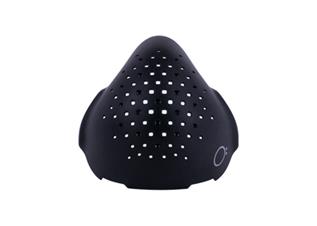
The price is around $70. Additional
filters are about $1.40 each.
Totobobo has Reusable Mask with
Electrostatically Enhanced Filters
This Singapore based company provides high
efficiency masks, Unique features include:
(1) Patented "Water-mark seal check" is easy and
reliable. (2) Customizable mask. You can shape
it and trim it. DIY to the unique face of each
of your family member. (3) Very flexible and
comfortable to the skin, superior fit due to the
SoftTech material. (4) Light reusable
respirator. Weight only 20 grams. (5) Super
elastic strap, comfortable and durable. (6)
Reproduction of bacteria or virus is prohibited
on the surface of the mask, thanks to the
anti-virus additive.
Poor face seal is poor protection. Over 90% of
1500 tests of N95 masks failed due to users
unaware of the leaks, According to a
published study by Tongji Medical College,
which conducted 1500 tests with 500 N95 masks on
50 Chinese.
To help identify any leaks, Totobobo developed
the "water-mark" method; the frost internal
surface of the mask turns into transparent when
it touches wet skin. The transparent water-mark
makes it easy to identify any gaps between the
mask and the user's face.
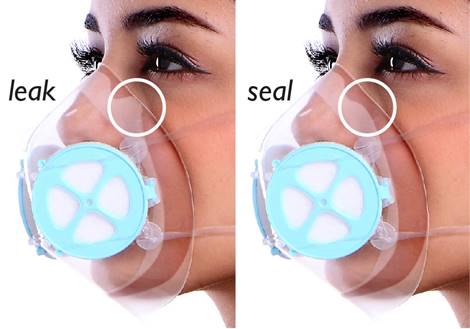
Masks are available at various efficiency
levels.
F96 (96%) filter - Extra high level of
protection. Breathe easier than typical N95
masks.
F94 (94%) filter - Easy to breathe while
maintaining high level of protection.
F92 (92%) filter - Most economic, high
efficiency for everyday use.
All above filters contains electro-static
charges and are highly effective to trap fine
dusts and particles even below 0.3 micron.
The mask is around $32 and can be reused
hundreds of times. Each set of two replaceable
electrostatic filters is around $2.
Respro® Mask has High Efficiency Valved Masks
and Lower Efficiency Scarves
The mask incorporates an Activated Charcoal
Cloth layer together with a submicron particle
filter layer (combination filter) as it has the
ability to adsorb viral matter in both the micro
and the nano range of sizes by means of
entrapment and adsorption. Suitable masks with a
combination filter:
Techno Mask
- (suitable for commuting)
Cinqro Mask
- (suitable for Sport)
Ultralight Combo
- (suitable for Sport)
Sportsta Combo
- (suitable for Sport)
Allergy Combo
- (suitable for commuting)
Skin plus Techno upgrade kit
- (suitable for Sport)
Techno Plus
- (suitable for Sport)
·
The effective working life of Respro® filters
depends on a number of factors, such as; the
breathing rate of the user; ambient levels of
pollution; the length of time the filter is
actively working; hygiene levels. Taking these
factors into account we recommend that the
filter should be replaced every month or every
69 hours, whichever is sooner.
·
Replacement of the Sportsta™ filter should be
carried out every month or when the filter
becomes noticeably discolored.
It is recommended that the neoprene shell of the
mask be washed every month under normal use. To
do this it is necessary to remove the filter and
the valve first.
https://respro.com/pg/faqs#faq1
